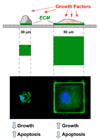Tensegrity-based mechanosensing from macro to micro
- PMID: 18406455
- PMCID: PMC2570054
- DOI: 10.1016/j.pbiomolbio.2008.02.005
Tensegrity-based mechanosensing from macro to micro
Abstract
This article is a summary of a lecture on cellular mechanotransduction that was presented at a symposium on "Cardiac Mechano-Electric Feedback and Arrhythmias" that convened at Oxford, England in April 2007. Although critical mechanosensitive molecules and cellular components, such as integrins, stretch-activated ion channels, and cytoskeletal filaments, have been shown to contribute to the response by which cells convert mechanical signals into a biochemical response, little is known about how they function in the structural context of living cells, tissues and organs to produce orchestrated changes in cell behavior in response to stress. Here, studies are reviewed that suggest our bodies use structural hierarchies (systems within systems) composed of interconnected extracellular matrix and cytoskeletal networks that span from the macroscale to the nanoscale to focus stresses on specific mechanotransducer molecules. A key feature of these networks is that they are in a state of isometric tension (i.e., experience a tensile prestress), which ensures that various molecular-scale mechanochemical transduction mechanisms proceed simultaneously and produce a concerted response. These features of living architecture are the same principles that govern tensegrity (tensional integrity) architecture, and mathematical models based on tensegrity are beginning to provide new and useful descriptions of living materials, including mammalian cells. This article reviews how the use of tensegrity at multiple size scales in our bodies guides mechanical force transfer from the macro to the micro, as well as how it facilitates conversion of mechanical signals into changes in ion flux, molecular binding kinetics, signal transduction, gene transcription, cell fate switching and developmental patterning.
Figures





References
-
- Alenghat FJ, Ingber DE. Mechanotransduction: all signals point to cytoskeleton, matrix, and integrins. Sci STKE. 2002. 2002:PE6. - PubMed
-
- Alenghat FJ, Nauli SM, Kolb R, Zhou J, Ingber DE. Global cytoskeletal control of mechanotransduction in kidney epithelial cells. Exp Cell Res. 2004;301:23–30. - PubMed
-
- Ausprunk DH, Folkman J. Migration and proliferation of endothelial cells in preformed and newly formed blood vessels during tumor angiogenesis. Microvasc Res. 1977;14:53–65. - PubMed
-
- Bernfield MR, Banerjee SD. The basal lamina in epithelial-mesenchymal interactions. In: Kefalides N, editor. Biology and Chemistry of Basement Membranes. New York: Academic Press; 1978. pp. 137–148.
Publication types
MeSH terms
Substances
Grants and funding
LinkOut - more resources
Full Text Sources
Other Literature Sources
Miscellaneous

